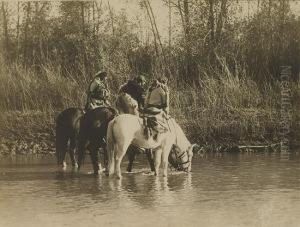Richard Throssel Paintings
Richard Throssel was an American photographer and artist of Cree heritage, born in 1882 in Marengo, Washington. Throssel's heritage was a mix of Cree and European ancestry, which deeply influenced his work and his perspective on the cultures he depicted. At the age of two, he was adopted by a family in Montana, where he was raised. His early life in the West sparked a lifelong interest in Native American cultures, particularly those of the Plains Indians.
In 1902, Throssel moved to the Crow Reservation in Montana, where he worked as an Indian agent. This period was pivotal for Throssel, as it immersed him in the Crow community and culture, allowing him to form deep connections and gain an intimate understanding of the people he would later photograph. During his time on the reservation, he was even adopted into the Crow tribe, a testament to the deep respect and affection the Crow people had for him.
Throssel’s photography career began to take shape when he was introduced to photography by Fred Miller, a fellow photographer who also worked on the Crow Reservation. Under Miller's mentorship, Throssel honed his skills and developed a distinctive style that combined a documentary approach with an artistic sensitivity to his subjects. He captured the daily lives, ceremonies, and portraits of the Crow people with a respect and empathy that was evident in his work. Throssel’s photographs are notable for their composition, depth, and the ability to convey the personality and spirit of his subjects.
By 1907, Throssel's work had gained recognition, leading to a collaboration with the American historian and ethnographer Edward S. Curtis. This collaboration further expanded Throssel's reach and influence in the field of Native American photography. Throughout his career, Throssel aimed to portray the dignity, beauty, and complexity of Native American life, countering the prevalent stereotypes and misconceptions of the time.
Richard Throssel's legacy is a rich portfolio of images that provide a rare and insightful glimpse into the lives of the Crow people in the early 20th century. His work not only serves as an important historical record but also as a testament to his skill as a photographer and his respect for the cultures he documented. Throssel died in 1933, but his photographs continue to be celebrated for their artistic and cultural significance.
